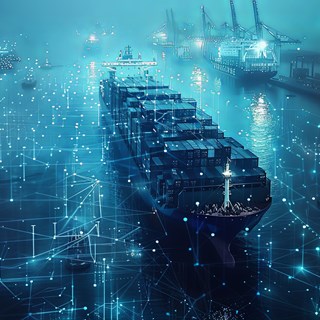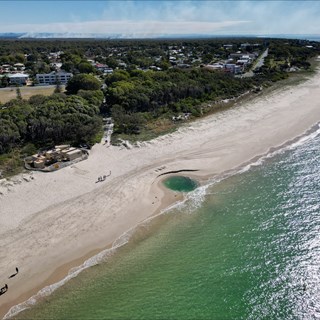
How Autonomous IaaS Is Reshaping Global Ocean Surveillance
The integration of autonomous maritime systems into the naval and commercial sectors is accelerating, driven by AI, distributed sensor networks, and long-duration autonomous platforms.
23 June 2025
This bylined feature is published with the authorisation of the author. It reflects our ongoing commitment to pioneering change in the global maritime domain.
By Graeme Nayler • Seamus Miller • Robert Dane
The integration of autonomous maritime systems into the naval and commercial sectors is accelerating, driven by AI, distributed sensor networks, and long-duration autonomous platforms. A significant enabler of this shift is low Earth orbit (LEO) satellite constellations, which are transforming maritime connectivity by providing seamless, high-bandwidth, low-latency communications. As seen in recent trials, these advancements enhance real-time situational awareness, enabling autonomous vessels to deliver continuous, scalable maritime intelligence.
The traditional paradigm of episodic, human-intensive ocean surveillance is being replaced by persistent, autonomous information-as-a-service (IaaS) models. LEO satellite technology is a key driver in this transformation, supporting real-time analytics, remote monitoring, and predictive modelling—critical for sectors spanning defense, environmental monitoring, and offshore energy.
At the forefront of this shift is autonomous USV deployments, such as the Deep Blue Project, which integrates AI-driven analytics with autonomous maritime platforms to deliver high-resolution, real-time intelligence. These advancements are shaping a new era of digitally enabled, data-rich maritime operations, where intelligence-led decision making is not just an advantage but a necessity.

The increasing complexity of global maritime operations—driven by factors such as security threats, climate change and offshore energy expansion—demands a fundamental shift in how persistent wide-area data are collected. Traditional surveillance models, reliant on manned patrols, periodic surveys, and legacy satellite systems, often lack efficiency, cost-effectiveness, and resilience in dynamic ocean environments. Autonomous platforms and AI-powered analytics now offer an alternative: one that is scalable, cost-efficient, and persistent.
Specifically, the vastness of the maritime domain presents inherent challenges for data collection. Regions such as the South China Sea, Strait of Malacca, and Bab el Mandeb Strait are not only strategic trade corridors but also high-risk zones for environmental impact and maritime security. Here, continuous, real-time ocean intelligence is critical, not just for governments and naval forces but also for commercial sectors managing climate-driven risks, regulatory compliance, and sustainability.
By integrating USV-collected ocean intelligence with AI-powered analytics, the Deep Blue Project is demonstrating how autonomous IaaS models can support a range and variety of applications, including offshore wind project planning, biodiversity conservation, climate risk forecasting, and subsea infrastructure monitoring.
The industry is transitioning from ad-hoc, project-based data collection to a continuous, intelligence-driven service model. Autonomous fleets such as the Deep Blue Project offer a game-changing alternative, capable of persistent ocean monitoring, real-time data fusion and actionable environmental insights. By integrating AI analytics and LEO connectivity, these systems not only enhance efficiency and reduce costs but also drive sustainability by lowering CO2 emissions and minimizing reliance on traditional crewed platforms. This is a pivotal shift in how governments, commercial operators, and environmental agencies approach maritime intelligence and mitigate risk.
The next leap forward in maritime domain awareness lies in the seamless integration of autonomous fleets, AI analytics and cloud-based decision support systems. The BMT DEEP platform is a prime example of how multi-source maritime data sets can be processed, visualized, and delivered as real-time insights to government, industry, and environmental stakeholders.
BMT and Ocius are collaborating at a pivotal moment in history, a time when technology and corporate expertise matches vision. We are part of a revolution driven by Moore’s Law, where sensors are becoming smaller, lighter, more powerful and cheaper. Combined with low-Earth orbit satellite communications and the power of artificial intelligence, autonomous, persistent and reliable data collection is not just possible—it is now disruptively affordable.
Today, BMT and Ocius’s Bluebottle USVs operate 24/7 in the waters off Australia for select customers, proving the capability. But we want to take another step forward: Our mission is to break down barriers and put real-time ocean intelligence into the hands of scientists, sailors, and CEOs through a transformative new business model.
With autonomous USV networks, the future of maritime data intelligence will be driven by: persistent environmental monitoring for climate impact assessments; continuous hydrographic and meteorological data collection for offshore energy optimization; maritime security surveillance to track illicit activity and emerging threats; and infrastructure resilience modeling for undersea cables, ports, and offshore platforms.
By adopting a networked approach, the industry is moving beyond legacy survey models toward a system that reduces costs, increases efficiency and enhances sustainability.
A key validation of autonomous IaaS at scale comes from the Deep Blue Project’s technical trial in Australia’s Gippsland region. Over a 22-day period, from November 19 to December 11, 2024, the Bluebottle USV fleet surveyed 46 km² of ocean, capturing 25 TB of environmental data under Sea State 5 conditions, proving its resilience and long-duration operational viability.
Simultaneously, BMT has been advancing the DEEP platform, which serves as the backbone of its autonomous intelligence solutions. This trial in Australia demonstrated how continuous, cost-effective data collection can drive commercial and operational efficiencies in offshore wind development, marine transport, conservation, and real-time security monitoring.
As AI capabilities within the DEEP platform continue to evolve, the project is now entering its commercialization phase, marking a significant step toward real-world deployment. The next phase of maritime intelligence will focus on predictive analytics, edge computing, and near-instant decision support—transforming how industries and governments interact with autonomous intelligence at scale. Additionally, this initiative delivers crucial maritime governance value, enhancing regulatory compliance, operational transparency, and data-driven decision making to support safer, more sustainable, and resilient maritime operations.
The shift from fragmented, localized data collection to persistent, global-scale intelligence is already happening. Maritime autonomy is not just an efficiency tool; it is essential for operational maximization. The ability to fuse AI, edge computing and autonomous platforms into a cohesive data ecosystem is defining the next generation of maritime decision making. As we refine the scalable DEEP platform architecture, the future of ocean intelligence will be shaped by predictive analytics, seamless multi-source data integration and real-time decision support.

The maritime sector is at an inflection point, where the integration of AI, autonomy and scalable IaaS solutions is redefining data-driven ocean intelligence. As proven through the Deep Blue Project’s successful trial, autonomous platforms are no longer experimental—they are operational, commercially viable and ready to be deployed at scale, offering game-changing capabilities for domain-agnostic operators.
With LEO satellite connectivity, AI-driven analytics and multi-source data fusion, real-time ocean intelligence is becoming a new industry standard. The ability to continuously monitor and analyze vast maritime regions is not simply about cost reduction; it is about delivering mission-critical, intelligence-led decision making.
The demand for real-time maritime intelligence is soaring across sectors, from offshore wind operators needing continuous metocean data to governments and defense agencies requiring persistent situational awareness. With exponential investment in autonomy across the Asia-Pacific region, including significant government funding in Australia and Japan, BMT is poised to support this transformation. Our Deep Blue Project is not only proving the operational resilience of autonomous systems but also demonstrating their value in delivering scalable, cost-effective intelligence for environmental monitoring, infrastructure resilience and maritime security.
As the industry morphs toward scalable, autonomous maritime solutions, the focus is now on fully optimizing these capabilities to enhance security, resilience and sustainability. Rather than simply adopting new technologies, the future of maritime operations lies in their seamless platform integration: ensuring they work in concert to maximize operational efficiency, de-risk decision making, drive sustainability and provide a strategic advantage in an increasingly complex maritime domain.
Credit Reference for Press/Promotional Use:
This exclusive, bylined feature in Sea Technology magazine’s May issue - dedicated to “Communications, Telemetry, and Data Processing” - showcases BMT’s leading role in advancing maritime innovation and digital transformation. Co-authored by BMT’s Graeme Nayler and Seamus Miller, alongside Rob Dane, CEO of Ocius, the article positions BMT at the forefront of industry thought leadership, demonstrating our expertise and influence in next-generation autonomous IaaS solutions. The editor’s selection of this piece for both the print and e-book editions further amplifies BMT’s reach and reputation across the global maritime and subsea sectors.

N/A
Are you using your port's data to make smarter, real-time decisions, or just collecting it without turning it into actionable insight? What if you could predict delays before they happen and optimize operations with the data you already have?

Chloe Yarrien
This International Women in Engineering Day, we’re celebrating Chloe Yarrien, our Maritime Autonomous Systems Engineering Lead - someone who’s making a lasting impact on the future of naval technology through expertise, collaboration and vision.

N/A
Read how our evaluation of Woorim Beach’s sand backpassing trial is helping the City of Moreton Bay address erosion challenges and optimise coastal protection strategies for the future.

Shane Amaratunga
As we celebrate 40 years of engineering excellence, I’ve been reflecting on what truly drives innovation in our business. For me, the answer is simple: it’s our customers.